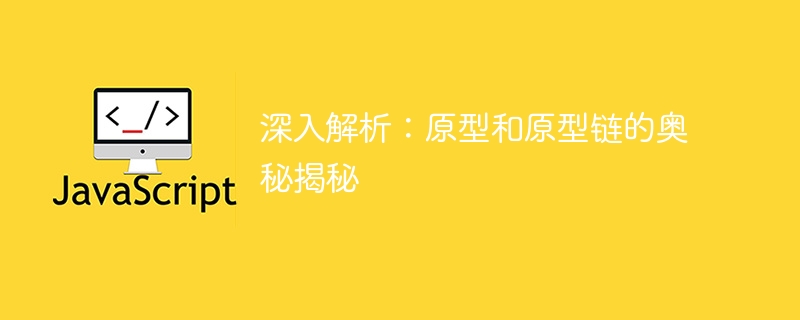Home >Web Front-end >JS Tutorial >Revealed: Exploring the Deep Mysteries of Prototypes and Prototype Chains
Revealed: Exploring the Deep Mysteries of Prototypes and Prototype Chains
- WBOYWBOYWBOYWBOYWBOYWBOYWBOYWBOYWBOYWBOYWBOYWBOYWBOriginal
- 2024-01-13 14:20:06836browse

In-depth analysis: The secrets of prototypes and prototype chains are revealed, specific code examples are needed
At first, JavaScript was a scripting language designed for simple web page interaction . However, with the rapid development of Internet applications, the importance of JavaScript has gradually become prominent. JavaScript has become a widely used programming language capable of implementing complex front-end and back-end logic. In this process, prototypes and prototype chains became important concepts in JavaScript.
In JavaScript, there is no concept of a class, but object inheritance is implemented through prototypes. Every object has a prototype object from which it inherits properties and methods. When we access a property or method of an object, if the object itself does not have this property or method, JavaScript will look for it in its prototype object, and this prototype object will have its own prototype object, thus forming a prototype chain.
Let’s better understand prototypes and prototype chains through concrete code examples.
// 创建一个构造函数
function Person(name, age) {
this.name = name;
this.age = age;
}
// 给构造函数的原型对象添加方法
Person.prototype.greet = function() {
console.log(`Hello, my name is ${this.name} and I am ${this.age} years old.`)
}
// 创建一个对象
var john = new Person("John", 25);
// 调用对象的方法
john.greet(); // 输出:Hello, my name is John and I am 25 years old.In the above example, we added a greet method to the prototype object of the constructor Person. Then, we created an object john through the new keyword and called the greet method. Since the john object itself does not have a greet method, the JavaScript engine will find the prototype object of Person through the prototype chain and call the greet method in it. .
The concepts of prototypes and prototype chains are very important for understanding inheritance in JavaScript. When we create an object, the JavaScript engine automatically associates a prototype object with the object, thereby realizing the sharing of properties and methods between objects. This not only saves memory space, but also allows you to easily add and modify the properties and methods of the object.
In addition to the above examples, we can also create objects and specify their prototype objects through the Object.create() method. Let's look at a concrete example.
// 创建一个原型对象
var personProto = {
greet: function() {
console.log(`Hello, my name is ${this.name} and I am ${this.age} years old.`);
}
};
// 创建一个对象并指定其原型对象
var sarah = Object.create(personProto);
sarah.name = "Sarah";
sarah.age = 30;
sarah.greet(); // 输出:Hello, my name is Sarah and I am 30 years old.In this example, we first create a personProto prototype object and define the greet method in it. Then, we created a new object sarah through the Object.create() method and set personProto to its prototype object. Finally, we manually added the name and age properties to the sarah object and called the greet method.
Through these two specific examples, we deeply analyzed the mysteries of prototypes and prototype chains. Prototype and prototype chain are the core mechanisms for implementing inheritance in JavaScript. By mastering this concept, we can better understand how JavaScript works and write more efficient and easier-to-maintain code. I hope this article can help readers better understand prototypes and prototype chains, and be able to use them flexibly in actual project development.
The above is the detailed content of Revealed: Exploring the Deep Mysteries of Prototypes and Prototype Chains. For more information, please follow other related articles on the PHP Chinese website!
Related articles
See more- An in-depth analysis of the Bootstrap list group component
- Detailed explanation of JavaScript function currying
- Complete example of JS password generation and strength detection (with demo source code download)
- Angularjs integrates WeChat UI (weui)
- How to quickly switch between Traditional Chinese and Simplified Chinese with JavaScript and the trick for websites to support switching between Simplified and Traditional Chinese_javascript skills

